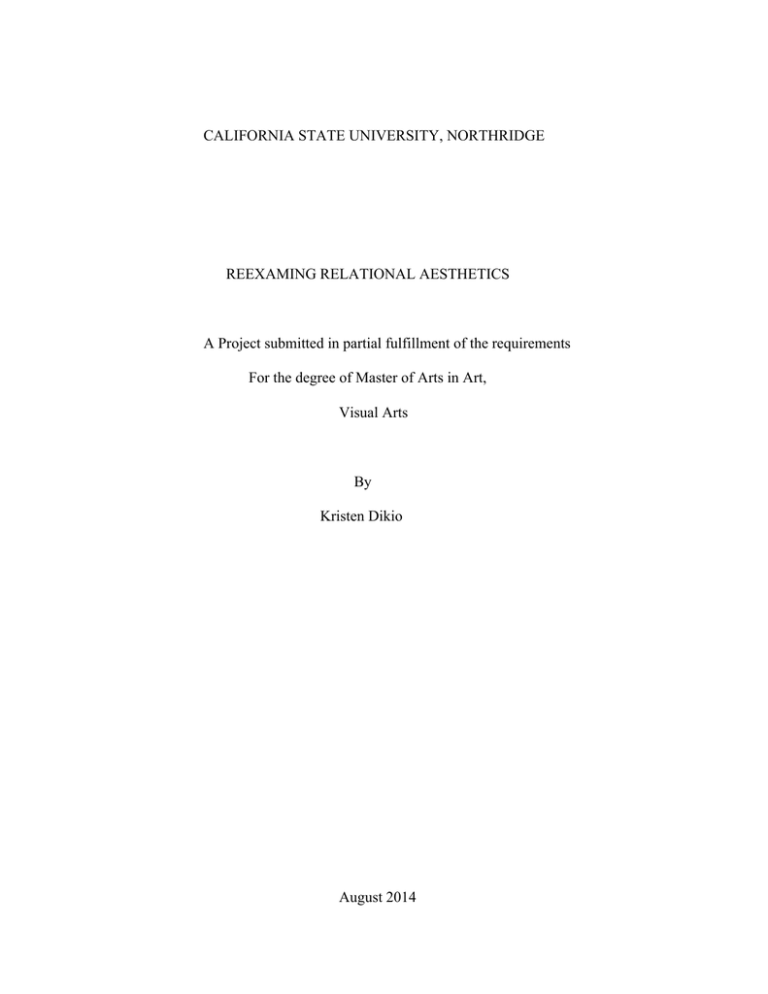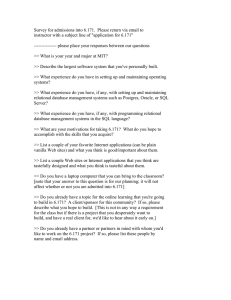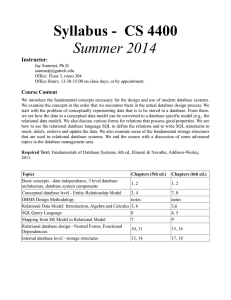CALIFORNIA STATE UNIVERSITY, NORTHRIDGE REEXAMING RELATIONAL AESTHETICS
advertisement

CALIFORNIA STATE UNIVERSITY, NORTHRIDGE REEXAMING RELATIONAL AESTHETICS A Project submitted in partial fulfillment of the requirements For the degree of Master of Arts in Art, Visual Arts By Kristen Dikio August 2014 The graduate project of Kristen Dikio is approved: ___________________________ Samantha Fields, M.F.A. __________________ Date ___________________________ Ron Saito, P.H.D. __________________ Date ___________________________ Christian Tedeschi, M.F.A., Chair __________________ Date California State University, Northridge ii TABLE OF CONTENTS Signature Page ii Abstract iv Introduction 1 Relational Aesthetics 2 Relational Antagonism 5 Reexaming the Terms 8 Role of the Artist 10 Role of the Viewer 11 Role of Community 12 Conclusion 13 References 14 Appendix 15 iii ABSTRACT REEXAMING RELATIONAL AESTHETICS By Kristen Dikio Master of Arts in Art, Visual Arts I create experiences through constructed objects, performance, and installations that are accessible to an inclusive audience; in this moment of engagement, the viewer is unified with the exclusive, rarefied gallery space. I explore themes regarding collaboration, public and personal space and finding inherent beauty in seemingly insignificant moments. My process challenges passive viewing by inviting the audience to exert its curiosity, oftentimes contributing to the outcome of the work. The viewer becomes an indispensable and productive element in the creative process, establishing a give-and-take dynamic that yields infinite outcomes unique to each participant. iv INTRODUCTION I create experiences through constructed objects, performance, and installations that are accessible to an inclusive audience; in this moment of engagement, the viewer is unified with the exclusive, rarefied gallery space. I explore themes regarding collaboration, public and personal space and finding inherent beauty in seemingly insignificant moments. I have often been hesitant to place myself in a certain category to avoid feeling confined, but as an artist, I must situate my work within a certain methodology to help others and myself better understand what I do. Through my continuous quest to find where I stand in the present world of art, I will examine the methodologies that I identify with in comparison to my work. 1 RELATIONAL AESTHETICS In an examination of relational aesthetics as a methodology, I will discuss Nicolas Bourriaud’s book, Relational Aesthetics. French curator and art critc, Bourriaud, first published his book in France in 1998 and later translated to English in 2002. Relational aesthetics is a term used to create critical dialogue regarding contemporary artists in the 1990’s using shared activities and participation in a social atmosphere. It is a process of collective thoughts and the act of formally addressing aspects of our world around us. Bourriaud writes, “The role of artworks is no longer to form imaginary and utopian realties, but to actually be ways of living and models of action within the existing real, whatever the scale chosen by the artist (Bourriaud, P. 13).” Since the 1960’s there has been a progression of contemporary art sparked from the advancement in technology. There is a shift in contemporary art through the change in social contexts through history. In the 1990’s, artist’s focused on the community created by the art and the consciousness of the relationship between the viewer and the art. The objective of the artwork is to create open conversation within a community and find meaning collaboratively. Marxism, the Dada and Fluxus movements, and Situationists paved the way for relational aesthetics through the birth of artwork that used a sense of randomness to show a “liberation through the irrational (Bourriaud, P. 12).” Artists built on theories embracing chance in response to authoritarian power and expressed a collective rejection of capitalist “logic”. To differentiate the participation based work of the 60’s with that of the 90’s, he argues that the 60’s artists focused on creating mini-utopias while those during the 90’s created archetypes for living in the present. According to Karl Marx’s 2 idea of a social interstice, the realm of art and the gallery is commonly known for buying and selling, but relational aesthetics implements free realms of potentiality and space for a representation of commerce with purely human exchange. Through relational art, the issues of the extreme integration of technology and machines can also be addressed. Bourriaud wrote this book as an observer of the artists who were making work with similar threads and intended to explain the work of a specific and current generation. “It is an idea that was actually the core of Relational Aesthetics already, the Marxist idea that there is no stable “essence” of humankind, which is nothing but the transitory result of what human beings do at a certain moment of history (Bartholomew, 2009).” Bourriaud recognized a lack of critical and theoretical dissertation regarding artists using inter-human relations in their practice, and created a framework through his idea of relational aesthetics. He did not intend for the act of participation to become emphasized as a foundation for artists who practiced relational aesthetics. His aim was to document a portrayal of a moment in time, with importance to the culture shift that was happening, in the present. Two popular relational artists are Rirkrit Tiravanija and Felix Gonzalez-Torres. Tiravanija is most well known for a work of art where he cooks food for the people coming into the gallery. He holds social gatherings that invite positive human exchange. The object of study is the conversations and interactions taking place within a constructed environment. Gonzalez-Torres creates process based installations and well known for his mounds of candy at a specific weight and invites viewers to take one. It is especially powerful in the “portrait” of his partner because the specific weight was that of his partner’s before his illness took over and metaphorically demonstrates his death, 3 watching a physical mass slowly waste away as viewers take pieces of it. GonzalezTorres explains the importance of participation in his work, stating, “I need the public to complete the work. I ask the public to help me, to take responsibility, to become part of my work, to join in (Ottman, 2002).” 4 RELATIONAL ANTAGONISM The foundation of Bourriaud’s, Relational Aesthetics, is based in a small and exclusive framework. Art historian, Claire Bishop, is one who challenges his methodology and introduces, ‘Relational antagonism’ in order to level out the playing field. In her book, Participation, first published in 2006, Bishop strives to expand the framework of viewer participation based artwork. Relational antagonism as a methodology portrays the antagonistic view of a democratic society, which to many people is not a harmonious one. The artists who practice relational antagonistic work involves human interaction, among different types of people or environments revealing the politics of a democratic society and the acknowledgement of inclusion and rejection. Bishop writes, “the relations set up by relational aesthetics are not intrinsically democratic, as Bourriaud suggests, since they rest too comfortably within an ideal of subjectivity as whole and of community as immanent togetherness. There is debate and dialogue in a Tiravanija cooking piece, to be sure, but there is no inherent friction (Bishop, P. 67).” Relational aesthetics is based on a small group of society including like-minded people so it is easy to build a feeling of community and in a sense it is already built. Bishop intended to widen the scope of human exchange taking place between people of different social classes, political views, perspectives and lifestyles. It exposes the division of a larger population and the inequality that unfolds. Relation antagonism confronts the concept of suppression that happens in the process of sustaining a harmonious society. A balance for these micro utopias is necessary for more critical engagement and 5 an awareness of reality and totality. What the viewer is supposed to take from an “experience”, in Bourriaud’s view of relational aesthetics, is unclear to Bishop, because it is still rooted within an institution. She questions the quality of the relationships made within these situations, and argues that there is a superficial happiness that does not bring those involved to a consequential resolution. Bishop opposes his ideas on “relations that permit dialogue” because she does not believe that just because a situation permits dialogue, does not automatically mean it is democratic or good. Bishop writes, “It is important to emphasize, however, that Bourriaud does not regard relational aesthetics to be simply a theory of interactive art. He considers it to be a means of locating contemporary practice within the culture at large: relational art is seen as a direct response to the shift from a goods to a service-based economy (Bishop, P. 54).” Bishop describes “the buzz” that surrounds the work that becomes more prominent than a productive outcome. She refers to, art critic, Hal Foster’s view on contemporary art, who wrote the book Design and Crime (And Other Diatribes). He raises awareness of the spectacle and the lack of substantial concepts embedded into the meaning of the work. Foster writes, “But surely one thing art can still do is to take a stand, and to do this in a concrete register that brings together the aesthetic, the cognitive and the crucial. And formlessness in society might be a condition to contest rather than to celebrate in art- a condition to make over into form for the purposes of reflection and resistance” (Bishop, P. 194). Santiago Sierra is an artist who uses participation that pushes the boundaries of art and encourages the rethinking of our relationship to the world and each other. Sierra uses participants in his performances to expose a social reality. In his work, 160 cm line 6 tattooed on four people, in 2000, he uses four female heroine-addicted prostitutes to sit topless in a row to get a line tattooed continuously across their backs, in exchange for the price of a shot of heroine. He uses his performances to exploit the degradation of lower class members of society including homeless, addicts, and prostitutes. He exposes the contradiction in society, reveals the way that capitalism exploits, and forces us, as viewers, to reflect on our own participation in a culture driven by profit. At the 50th Venice Biennale in Spain, Sierra covered the word “Espana” and blocked off the pavilion to anyone who did not have a Spanish passport. The pavilion only held the remnants of the previous installation. Sierra writes, “A nation is actually nothing; countries don’t exist. They are political construction. The work was also people who were passing by it. The piece was not the empty space but rather the situation (Margolles, 2004, P.3).” The implementation of this border automatically placed Biennale viewers on either side, defined them through an ideological territory, and spoke to the political construction of boundaries created by humans. The use of participation has a lot of potential to be a rich and powerful means for conveying a message through art, but in Bishop’s view continuing the institutionalized social harmony, of relational aesthetics, can be exclusive, idealistic, and entertainment without substance. 7 REEXAMINING THE TERMS Although the term ‘relational aesthetics’ was born in the 1990’s, it is relevant today because it is in everything that we do. Relational aesthetics is a part of life and can be carried out through one’s existence in this reality. The interactivity of everyday life is a way of practicing relational aesthetics. I am skeptical of Bourriaud’s explanation of differences between artists from the 60’s and those of the 90’s. Naturally, there is a difference in social and historical context, which is the result of the progression of time, but ultimately, relational artists from the 90’s created work that directly came from what started in the 60’s. I do, however, appreciate Bourriaud’s intention to unify works that use the medium of human exchange but can understand Bishop’s frustration with the use of a word like ‘relational’ in such a confined window of human interaction. Perhaps a more appropriate term for Bourriaud’s explanation of relational aesthetics would be ‘social constructions’. There are different types of human exchange and those differences should be addressed when talking about relational art. ‘Social constructions’ speaks more about the friendliness of social gatherings and the idea of building a sense of community. It is more logical to explain Relational aesthetics as a large umbrella encompassing many other parts of human interaction. It can go beyond artists that create experiences for positive human interaction to include artists who uncover the dark side of human exchange that happens through greed and the need of immediacy in society. I am not convinced by Bishop’s claim that relational aesthetic artists lack substance. I believe there is room for both methods of participation based work and can be equally effective depending on each individual situation. Acts of generosity as well as exposing dark 8 truths have the potential to be powerful and inspiring. I believe the two ways of working are very different, but on the same level of legitimacy in the progression of art. My intention is to re-evaluate the term relational aesthetics as the broader idea of human exchange. Within this larger idea of relational aesthetics, there could be both social constructions and relational antagonism. After reexamining these terms, I can situate myself as an artist who practices relational aesthetics. Creating interactive experiences, both inside and outside the gallery space, is how I address the value in human connection and identify the energy and expression that is often lost between people. I use existing and invented systems to explore themes of collaboration, public and personal space, the importance of art in society, and to insert a creative mindset directly into the viewer's reality. I use an interactive means to explore the study of what is found amongst the exchange of artist to viewer and the effect of an artwork’s intended meaning on an individual’s daily life. Through social constructions, I use the term, ‘interactive systems’ to identify my work even further. This suggests the interconnectivity by organizing new systematic activities. There is a preconceived structure that gives the artwork a guide in the way information is gathered by the viewer. Often the structure is created with a set of guidelines and invites the viewer to participate within a set of parameters. I focus on the role of the artist, the role of the viewer, and the role of community. 9 THE ROLE OF THE ARTIST The role of the artist is important in my work entitled Call for Submissions. Lined up on a five foot long shelf, was a stack of blank paper, a container with pens, a timer, a blank space for drawing, a submission box, and a stack of art show flyers. This, along with a list of directions disguised as my artist statement, guided viewers through the steps of submitting work into a spin off art show. The viewer grabbed a blank sheet of paper and a drawing tool, started the timer, and made something within a brief time frame, then placed it into the submission box and took a flyer for the show that they just became a part of. Through this experience, I changed the role of the artist by initiating individual creative action from the viewer and creating a work of art that depended on the works of people who came through the gallery. I also reversed the role of the viewer by switching a system that previously required looking or hearing to the act of creating something. It was specifically created for a gallery space within a college art department because art students attending the show shared the desire to participate in showing their work. 10 THE ROLE OF THE VIEWER Trash from the pockets of people looking at art is another work that deals with the role of the viewer. It is a yellow sweater coated in resin and a note on the wall invites the viewer to place a piece of trash from their pockets or purse into the sleeve of the sweater and make a wish. There is an opportunity in these seemingly insignificant moments in life, to reverse a tiny daily inconvenience like throwing away random pieces of trash that accumulated in your pocket, into a hopeful moment like making a wish. I believe in the importance of nurturing one's imagination. As the artist, I would rather initiate creative thought or action within the viewer by communicating directly through the work. When the viewer is provided with an opportunity to think about what is meaningful for them in this moment, it can potentially transcend the gallery context into a more powerful moment of hope for each individual. 11 THE ROLE OF COMMUNITY In much of my work, the personal relationship of artist and audience is apparent, but there is one more important role that is often addressed, and it is the role of the community. During the summer of 2013, I worked on a collaboration piece with fellow student and photographer, Nichole Gawalis, entitled Eight Eighty-Eight. We traveled the west coast with a typewriter, a scroll of paper, and instant film. We asked people to write anything they wanted on the scroll, while they typed, a picture was taken, the date was written and they left with a photo. This work centered around the documentation of the exchanges between each person that we encountered along our journey. This glorified the exchanges between people who appreciated the interaction and exposed the conditioned skepticism most of American society has towards strangers on the street. The community who surrounded us consistently shaped our piece to what it became. The man who suddenly tore off a page from the typewriter, the kid who had to go back to Afghanistan in two weeks, and the girl on the street who just wanted to be heard all became a part of this scroll of a collective stream of thoughts. The outcome of this project was dependent on the unique individuals who participated and if repeated will never be the same again. This suggests the importance of each person in our community and the difference one can make. 12 CONCLUSION My work initiates self-reflection and creative thought. It suggests the importance of the individual and as the piece is experienced, preserves the marks of viewers as a part of this community. I create work that is not concerned merely with the enjoyment of people in a social atmosphere, nor is it just made to unmask the disheartening reality of our society. I intend to encourage the viewer to participate in a collaboration of collective creativity and promote the importance of art in our society. 13 REFERENCES Bartholomew, Ryan (2009, March). “Altermodern: A Conversation with Nicolas Bourriaud.” Art in America. Web. 7 April 2013. http://www.artinamericamagazine.com/news-opinion/conversations/200903-17/altermodern-a-conversation-with-nicolas-bourriaud/ Bishop, Claire (2006). Participation. London: Whitechapel Ventures Limited. Bishop, Claire (2004). “Antagonism and Relational Aesthetics.” October. Fall 2004: 67. Print. (P.51-79). Bourriaud, Nicolas (1998). Esthétique Relationnelle (Relational Aesthetics). France: Les presses du réel. Foster, Hal (2002). Design and Crime (And Other Diatribes). London: Verso. Margolles, Teresa (2004, December-February). “Santiago Sierra by Teresa Margolles.” BOMB Magazine. Web. 7 April 2013. http://bombsite.com/issues/86/articles/2606 Ottman, Klaus (2002, April). “Spiritual Materiality: Contemporary Sculpture and the Responsibility of Forms.” Sculpture Magazine. 21.3. Web. 15 March 2014. http://www.sculpture.org/documents/scmag02/april02/ottoman/otto.shtml 14 APPENDIX Call for Submissions. 2012. JPEG 15 Call for Submissions (Detail of the Spin Off show). 2012. JPEG 16 Trash from the pockets of people looking at art. 2013. JPEG 17 Eight Eighty-Eight. 2013. JPEG Eight Eighty-Eight (process shot). 2013. JPEG 18




